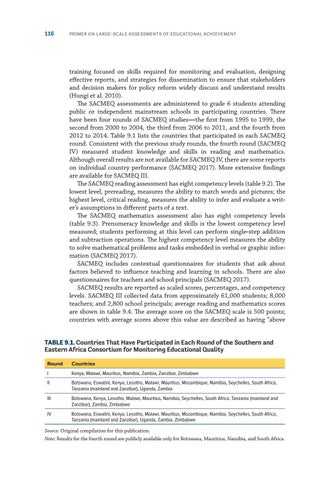116
PRIMER ON LARGE-SCALE ASSESSMENTS OF EDUCATIONAL ACHIEVEMENT
training focused on skills required for monitoring and evaluation, designing effective reports, and strategies for dissemination to ensure that stakeholders and decision makers for policy reform widely discuss and understand results (Hungi et al. 2010). The SACMEQ assessments are administered to grade 6 students attending public or independent mainstream schools in participating countries. There have been four rounds of SACMEQ studies—the first from 1995 to 1999, the second from 2000 to 2004, the third from 2006 to 2011, and the fourth from 2012 to 2014. Table 9.1 lists the countries that participated in each SACMEQ round. Consistent with the previous study rounds, the fourth round (SACMEQ IV) measured student knowledge and skills in reading and mathematics. Although overall results are not available for SACMEQ IV, there are some reports on individual country performance (SACMEQ 2017). More extensive findings are available for SACMEQ III. The SACMEQ reading assessment has eight competency levels (table 9.2). The lowest level, prereading, measures the ability to match words and pictures; the highest level, critical reading, measures the ability to infer and evaluate a writer’s assumptions in different parts of a text. The SACMEQ mathematics assessment also has eight competency levels (table 9.3). Prenumeracy knowledge and skills is the lowest competency level measured; students performing at this level can perform single-step addition and subtraction operations. The highest competency level measures the ability to solve mathematical problems and tasks embedded in verbal or graphic information (SACMEQ 2017). SACMEQ includes contextual questionnaires for students that ask about factors believed to influence teaching and learning in schools. There are also questionnaires for teachers and school principals (SACMEQ 2017). SACMEQ results are reported as scaled scores, percentages, and competency levels. SACMEQ III collected data from approximately 61,000 students; 8,000 teachers; and 2,800 school principals; average reading and mathematics scores are shown in table 9.4. The average score on the SACMEQ scale is 500 points; countries with average scores above this value are described as having “above TABLE 9.1. Countries That Have Participated in Each Round of the Southern and Eastern Africa Consortium for Monitoring Educational Quality Round
Countries
I
Kenya, Malawi, Mauritius, Namibia, Zambia, Zanzibar, Zimbabwe
II
Botswana, Eswatini, Kenya, Lesotho, Malawi, Mauritius, Mozambique, Namibia, Seychelles, South Africa, Tanzania (mainland and Zanzibar), Uganda, Zambia
III
Botswana, Kenya, Lesotho, Malawi, Mauritius, Namibia, Seychelles, South Africa, Tanzania (mainland and Zanzibar), Zambia, Zimbabwe
IV
Botswana, Eswatini, Kenya, Lesotho, Malawi, Mauritius, Mozambique, Namibia, Seychelles, South Africa, Tanzania (mainland and Zanzibar), Uganda, Zambia, Zimbabwe
Source: Original compilation for this publication. Note: Results for the fourth round are publicly available only for Botswana, Mauritius, Namibia, and South Africa.

